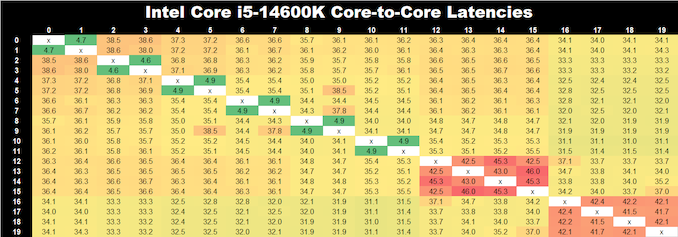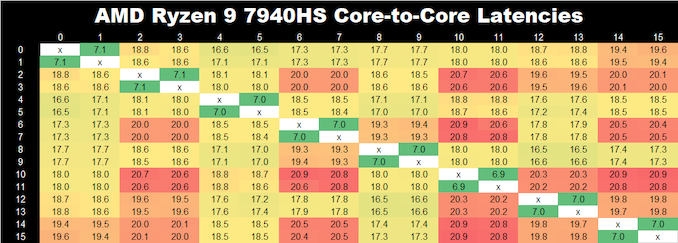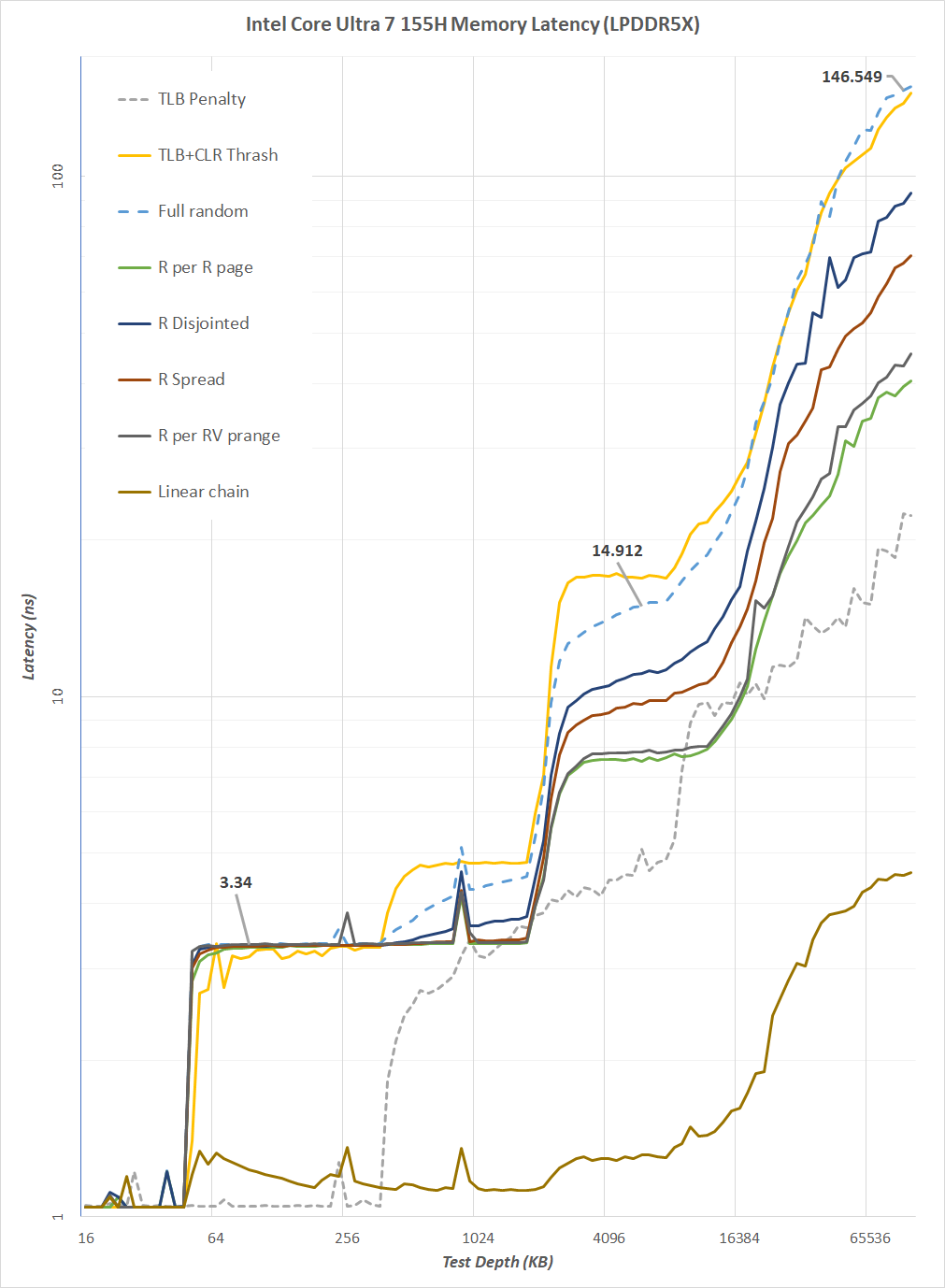The Intel Core Ultra 7 155H Review: Meteor Lake Marks A Fresh Start To Mobile CPUs
by Gavin Bonshor on April 11, 2024 8:30 AM ESTCore-to-Core Latency: Meteor Lake vs. Phoenix vs. Raptor Lake
As the core count of modern CPUs is growing, we are reaching a time when the time to access each core from a different core is no longer a constant. Even before the advent of heterogeneous SoC designs, processors built on large rings or meshes can have different latencies to access the nearest core compared to the furthest core. This rings true especially in multi-socket server environments.
But modern CPUs, even desktop and consumer CPUs, can have variable access latency to get to another core. For example, in the first generation Threadripper CPUs, we had four chips on the package, each with 8 threads, and each with a different core-to-core latency depending on if it was on-die or off-die. This gets more complex with products like Lakefield, which has two different communication buses depending on which core is talking to which.
If you are a regular reader of AnandTech’s CPU reviews, you will recognize our Core-to-Core latency test. It’s a great way to show exactly how groups of cores are laid out on the silicon. This is a custom in-house test, and we know there are competing tests out there, but we feel ours is the most accurate to how quick an access between two cores can happen.
In this core-to-core latency analysis, we'll compare the Intel Core Ultra 7 155H, based on their latest Meteor Lake architecture, directly to a similar processor from Raptor Lake, the Core i5-14600K. Both have the same 6P+8E core configuration, with the Core Ultra 7 155H coming with two Low Power Island (LP) Efficiency cores embedded within the SoC.
These LP E cores are based on the same Crestmont microarchitecture as the larger Efficiency cores within the compute tile but are designed to operate with a lower voltage-to-frequency (V/F) curve, emphasizing that they are designed to operate at an overall lower power envelope. The key idea is that the LP E cores offload the lightest and least demanding background tasks with the aid of Intel's Thread Director – and ideally, avoid powering up the compute tile altogether for mundane background threads.
Looking at the core-to-core latencies of the Intel Core Ultra 7 155H, which showcases the physical topology of the processor itself, there are a couple of interesting points to note. Firstly, Intel's Meteor Lake compute tile with both the P-core and E-cores that are built on the Intel 4 node employ a similar bi-directional cache coherence as per its previous architectures, such as Alder Lake and Raptor Lake. From Intel's previous heterogeneous architectures, such as Alder Lake and Raptor Lake,
Starting with the Redwood Cove (P) core cluster on the Core Ultra 7 155H, we can see that the inter-core latency access latencies across the P-cores range from 4.5 to 4.9 ns, which is very similar to that of Raptor Lake via the Core i5-14600K, which sits between 4.6 and 4.9 ns; this indicates that both have a very similar topology. Interestingly, Intel has placed a single P-core at the front of the topology, which has an inter-core latency of 5 ns. Going outside to contact other cores, the latency increases within the P-Core cluster up to 39.9 ns, which is very similar to Raptor Lake.
For the E-cores, the latencies shoot up to between 57.9 and 74.8 ns per each L1 access point, with the two first E-cores having a latency of just 5.0 ns. For reference, the Core i5-14600K, which is based on Raptor Lake, has lower efficiency core-to-core latencies of between 41.5 and 46 ns. Outside of the initial L1 access, the latencies shoot up, as expected, to between 45.2 and 75.4 ns at the top end of the scale.
Lastly, the Low-Power Island E-cores are designated as Core 20 and 21. They have much higher latencies of up to 152 ns, which isn't very efficient when communicating with cores in other clusters. They also have the longest route to take to reach any other core clusters, since they need to go off-die over to the compute tile to talk to the rest of the CPU cores. However, even between themselves, the core-to-core latency is still high, at 116.8 ns. This strongly emphasizes how the LP cores are not meant to be treated as part of the larger pool of CPU cores for multi-threaded tasks, and instead are best left to handle background activities.
Throwing AMD's Ryzen 9 7940HS into the mix, the Phoenix architecture uses AMD's Zen 4 cores on an FP8 chipset and is built using TSMC's 4 nm node. With a monolithic core and cache coherency structure, the inter-core-to-core latencies on this chip are higher than Intel's P-Core cluster on both Meteor Lake and Raptor Lake, with a consistent L1 range of between 7.0 and 7.1 ns. Hopping between other cores within the cluster on the Ryzen 9 7940HS, latencies hit up to 20.8 ns, which is much lower overall than the heterogeneous architecture Intel is using with P and E-cores while adding the LP E cores into the mix to push these latencies higher.
Cache Latencies
Examining the Core Ultra 7 155H's memory latency with LPDDR5X, the above graph looks at various test depths and shows the impact on latency through the different levels of cache. The baseline latency for linear memory access patterns remains consistently the lowest, with efficient[ prefetchers in using predictable patterns,
Across random access scenarios, the full random test exhibits higher latency across all depths, highlighting the increased time required for memory accesses when they are not sequential. This is a common challenge for CPUs when dealing with unpredictable data access, which is more typical than not within many real-world applications.
Latency inherently shoots skyward when we cross the L1 and L2 cache thresholds, as evident from the latency jumps at specific test depths. An example of this is at the 1024 KB test depth, where we can see an increase in latency for random access patterns. This means that the test depth exceeds the capability of the cache, as the Core Ultra 7 155H has to fetch data from the DRAM.
Focusing on Translation Lookaside Buffer (TLB) performance, our data indicates the Core Ultra 7 155H suffers a latency penalty whenever a TLB miss occurs (TLB Penalty line), which aligns with the expected behavior when data extends beyond the cache. The latency further skyrockets whenever TLB misses, and the TLB+CLR Thrash line points towards worst-case scenarios in memory access.
As the test depth extends to 16384 KB and beyond, nearly all memory access patterns converge towards higher latencies, indicating the reliance on main memory as the cache sizes are exceeded. This suggests that despite increasing latency with larger caches within Meteor Lake's memory hierarchy, the Core Ultra 7 155H still benefits from an overall larger cache capacity, which should result in higher performance with data stored within the cache instead of accessing data externally.
The Meteor Lake memory subsystem is nearly identical to that we've seen on Raptor Lake via the Core i5-14600K, which is also highlighted, and it seems designed to optimize for larger cache capacities while trying to negate any trade-offs in latencies. The Core Ultra 7 155H CPU does seem to navigate these trade-offs, managing various access patterns with varying efficiency, at least within the 1024 KB testing depth and below.
In contrast to AMD's Phoenix mobile architecture using Zen 4, which closely resembles the cache of Zen 3, albeit with more L2 and an uptick in cycles, we can see a spike in TLB+CLR Thrashing compared to Meteor Lake. Still, inherently, below the 1024 KB test depth, both memory substructures on Meteor Lake and Phoenix remain competitive. Beyond 1024 KB, we see higher latencies, which is a direct result of crossing the L1 and L2 TLB thresholds at 112 KB of L1 per P-core and 2 MB of L2 per P-core.














69 Comments
View All Comments
jeenam - Friday, April 12, 2024 - link
I've been an anandtech reader since 1998 or so and I'm not here to pick a bone. I'm a fan, and hope AT lives on. But did a quick search and the only two major websites with GPU reviews that referenced Returnal or Company of Heroes were Hot Hardware and Ars Technica. An expanded test suite of games might have been more appropriate because it's likely the ARC GPU would have been handily beaten across the board. Replysjkpublic@gmail.com - Thursday, April 11, 2024 - link
Strange. Some of the tests list the 155H as 28W with test results. This is misleading as the SoC uses much more power doing the test. ReplyGavin Bonshor - Friday, April 12, 2024 - link
When we review CPUs, especially when highlighting them in the charts, we list the base TDP, as every motherboard has its own interpretation of what level of power it will push through the chip (Multi-core enhancement). ReplyCarmen00 - Friday, April 12, 2024 - link
Yet in another comment, we have Ryan Smith saying "With these integrated devices, we're reviewing the notebook as much as we're reviewing the chip inside."So if you're doing what he says—post the right numbers, because that's what you're doing. And if you're NOT doing what he says, then don't post useless stuff that seems, to my (perhaps overly-critical eye) to exist so that the article can claim that Intel is scoring SOME kind of a win, when the graphs really don't seem to show a heck of a lot of CPU-related win.
I'm fine with either, let me be honest. But I want to see some consistency, that is all. Reply
Ryan Smith - Friday, April 12, 2024 - link
I'm all for trying to make sure you guys get the data that you want to see. But not sure I follow here. We are being consistent in our testing methodology, and taking care to be explicit in that our test systems don't have identical TDPs.https://images.anandtech.com/doci/21282/Core%20Ult...
In a laptop, sustained TDPs are our primary concern, as these devices cannot turbo multiple cores for more than a few seconds. So this is what we're noting in an article like this, to illustrate how we aren't testing devices with matching TDPs. Reply
ballsystemlord - Friday, April 12, 2024 - link
I agree with Ryan here, sustained performance is what you should be looking at. Anything can turbo to infinity.The only real use case for turbo, would be application start-up. But even then, you'd have to be waking the PC from idle and selecting the application in record time for it to matter at all. Reply
lmcd - Wednesday, April 17, 2024 - link
The problem I'm seeing is that this article takes the format of previous laptop reviews but not the depth (in part due to the declining access this publication), and the headline could better fit the contents. It could even be something silly like "The Intel Core Ultra 7 155H Review: Meteor Lake starts with a Moment of Zen(Book)" and be more valuable to the reader.It also did not feel like we really got (even a rehash of) an overview of Meteor Lake as a platform. So to me, this was an ASUS Zenbook review. Framing this as "ASUS ZenBook 14 OLED: A Meteor Lake Thin&Light Review" also better captures its content. Reply
eastcoast_pete - Friday, April 12, 2024 - link
I am not surprised that the Core 7 Meteor Lake isn't beating the Ryzen 7840HS in compute or graphics - that particular Ryzen 4 monolith is (IMHO) currently AMD's best foot forward, and a great APU. However, Intel did do its homework when it comes to the intended use of Meteor Lake SoCs: mobile, especially light and ultralight laptops and 2-in-1s. I don't expect a ~ 1 kg notebook to do that much higher level gaming or compute. I do expect long runtime on battery, fluid use of office and other productivity apps, and otherwise decent performance (speed). Again, AMD's Phoenix/Hawk APUs are, right now, the most performant solutions in that class, but it's good news for all of us that Intel has closed the gap. It'll mean that AMD will have to keep evolving its APUs, and maybe do a better job making them broadly available with good drivers within a few months of announcing them. Because that was not the case with Phoenix, which just took too long to be ready for prime time, and left the opening for Intel to move back into.Lastly, I find that one of the most remarkable things about Meteor Lake is that Intel got its tile design and packaging working quite well. Being able to combine different chips from different fabs (Intel and TSMC) and nodes into a cohesive unit without incurring large hits on performance and efficiency is big step forward. Reply
nandnandnand - Saturday, April 13, 2024 - link
Lunar Lake will be the one to watch. It's Meteor Lake-U evolved (4+4 instead of 2+8, on-package memory by default, decent graphics). Low power mobile chips are more interesting than the 45W+ ones. Replymode_13h - Monday, April 15, 2024 - link
> Being able to combine different chips from different fabs (Intel and TSMC)> and nodes into a cohesive unit without incurring large hits on performance
> and efficiency is big step forward.
AMD combined chiplets from both TSMC and Global Foundries in the same CPU, all the way back in Zen 2! If you count HBM, they combined chiplets from different foundries as far back as their HD Fury GPUs.
As for performance and efficiency, I find Meteor Lake underwhelming on both fronts. Idle performance and things like video playback gain a benefit from the new SoC architecture, but when it comes to compute-intensive tasks, we see why Intel kept around Raptor Lake for the performance-oriented segment. Reply